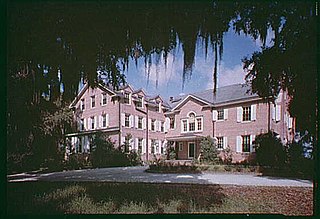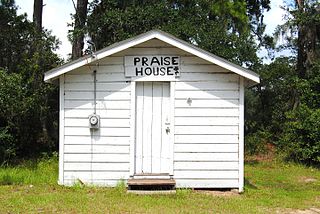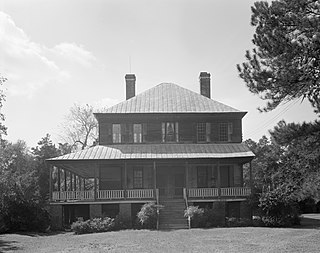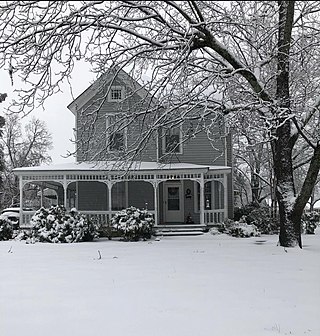
Berkeley County is a county in the U.S. state of South Carolina. As of the 2020 census, its population was 229,861. Its county seat is Moncks Corner, and the largest community is Goose Creek. After two previous incarnations of Berkeley County, the current county was created in 1882. Berkeley County is included in the Charleston-North Charleston, SC Metropolitan Statistical Area.

Waynesville is the county seat of Haywood County, North Carolina, United States. It is the largest town in North Carolina west of Asheville. Waynesville is located about 30 miles (50 km) southwest of Asheville between the Great Smoky and Blue Ridge Mountains.

Bernard Ralph Maybeck was an American architect. He worked primarily in the San Francisco Bay Area, designing public buildings, including the Palace of Fine Arts in San Francisco, and also private houses, especially in Berkeley, where he lived and taught at the University of California. A number of his works are listed on the National Register of Historic Places.

Pinopolis is an unincorporated community and census-designated place in Berkeley County, South Carolina, United States. As of the 2010 census it had a population of 948.

Hanover House is a colonial house built by a French Huguenot family in 1714–1716, on the upper Cooper River in present-day Berkeley County of the South Carolina Low Country. The house is also known as the St. Julien-Ravenel House after its early owners.

Hobcaw Barony is a 16,000-acre (65 km2) tract on a peninsula called Waccamaw Neck between the Winyah Bay and the Atlantic Ocean in Georgetown County, South Carolina. Much of Hobcaw Barony is south of US Highway 17. The land was purchased by the investor, philanthropist, presidential advisor, and South Carolina native Bernard M. Baruch between 1905 and 1907 for a winter hunting retreat. Later, his eldest child, Belle W. Baruch, began purchasing the property from her father beginning in 1936. By 1956, Belle owned Hobcaw Barony entirely. Upon her death in 1964, the property was transferred to the Belle W. Baruch Foundation for a nature and research preserve. The property includes more than 37 historic buildings and structures representative of the eras of both 18th & 19th century rice cultivation and 20th century winter retreats. Hobcaw Barony was named to the National Register of Historic Places on November 2, 1994.

Halifax Historic District is a national historic district located at Halifax, Halifax County, North Carolina, US that was listed on the National Register of Historic Places in 1970. It includes several buildings that are individually listed on the National Register. Halifax was the site of the signing of the Halifax Resolves on April 12, 1776, a set of resolutions of the North Carolina Provincial Congress which led to the United States Declaration of Independence gaining the support of North Carolina's delegates to the Second Continental Congress in that year.

Eddings Point Community Praise House is a historic church located on Saint Helena Island near Frogmore, Beaufort County, South Carolina. It was built about 1900, and is a narrow, one-story gable roofed building of frame construction with the entrance in the gable end. It is significant as one of four known extant African-American praise houses on St. Helena Island, and was a central place in the religious and social life of the black islanders.
Orange Grove Plantation is a historic plantation house and national historic district located on Saint Helena Island near Frogmore, Beaufort County, South Carolina. The district encompasses one contributing building and two contributing sites, and reflects the early-20th century influx of Northerners onto St. Helena Island. The plantation was first recorded in 1753 when Peter Perry purchased 473 acres. Perry owned 46 chattel slaves. The plantation house, built about 1800, was in poor condition when Henry L. Bowles (1866-1932), a U.S. Representative from Massachusetts, bought the property in 1928. He demolished it and built the present house in the same year. The property also includes the tabby ruin of the kitchen, built about 1800, and a tabby-walled cemetery containing three early-19th century graves of the Fripp and Perry families.

Lawson's Pond Plantation is a historic plantation house located near Cross, Berkeley County, South Carolina. It was built about 1823, and is a large two-story clapboard structure set upon high foundations. It has a hipped roof and features a one-story piazza along the front and left facades.

Lewisfield Plantation is a historic plantation house located near Moncks Corner, Berkeley County, South Carolina. It was built about 1774, and is a 2 1/2-half story clapboard dwelling. It is supported by a high brick foundation that encloses a raised basement. It has a five bay wide verandah supported by six slender Doric order columns. Records show over 100 slaves were held in bondage on the plantation as of 1835.
Richmond Plantation, also known as Girl Scout Plantation, is a national historic district located near Cordesville, Berkeley County, South Carolina. It was built about 1927, and includes a manor house and outbuildings constructed as a hunting lodge for George A. Ellis, a prominent New York financier and co-founder of E. F. Hutton & Co.

William Robertson House, also known as Wampee Plantation Summer House, is a historic home located at Pinopolis, Berkeley County, South Carolina. It was built about 1844, and is a two-story, three-bay, frame I-House, sheathed in weatherboard. It features a hip roofed, one-story porch spanning the façade and wrapping around the right elevation. The house was one of the early planters' retreats in the pineland village of Pinopolis.
Quinby Plantation House-Halidon Hill Plantation is a historic plantation house located near Huger, Berkeley County, South Carolina. The house was built about 1800, and is a 2+1⁄2-story, five-bay, frame Federal style plantation house. It sits on a low brick foundation and has a gable roof. In 1954, in order to save Quinby Plantation from destruction, the owners moved it approximately four miles to Halidon Hill Plantation. Halidon Hill Plantation is associated with the lowcountry rice culture and was historically part of Middleburg Plantation.
Cainhoy Historic District is a national historic district located near Huger, Berkeley County, South Carolina. It encompasses nine contributing buildings, which range in date from the mid-18th century through the early-20th century. They represent the development of the village from a ferry landing to a small but thriving river port. It was the site of America's first porcelain factory, established by John Bartlam in 1765. Each building is a vernacular specimen from its respective period, including the Federal style. Cainhoy's significance lies in its role as an early transportation link between inland Berkeley County and Charleston and in its fine collection of early buildings. In 1876, Cainhoy was the site of a political rally for Wade Hampton (1818-1902) which degenerated into a brawl between blacks and whites. Christened the "Cainhoy Massacre," the incident left seven men dead and sixteen wounded.
Pinopolis Historic District South is a national historic district located at Pinopolis, Berkeley County, South Carolina. It encompasses 12 contributing buildings and consists of the historic core of the planters retreat community of Pinopolis. The district contains numerous early to middle-19th century summer houses, the Gothic Revival influenced Pinopolis Methodist Church, and other later 19th century buildings including some in the Queen Anne style. The buildings of the Pinopolis Historic District South are representative of the development of vernacular building forms and construction technology of the 19th century. The absence of stylistic pretensions in most of the buildings is typical of pineland village architecture.

Pineville Historic District is a national historic district located at Pineville, Berkeley County, South Carolina. It encompasses seven contributing buildings and illustrates Pineville's original role as a 19th-century pineland village, and its gradual transformation to agricultural land and to a year-round community in the late-19th and early-20th centuries. The Pineville Historic District consists of four principal buildings, three residential buildings and one Episcopal church, ranging in date from about 1810 through 1925. The architectural styles represented include Federal, Greek Revival, and Bungalow. In the mid to late-19th century, Pineville was a densely settled village that included as many as one hundred buildings, including an academy, racetrack, library, churches, and residences. Much of the town was burned by Union troops at the close of the American Civil War in April 1865. In the years following the war, much of the land that made up the village was converted for use as farmland. Since that time, Pineville has remained a small community of less than 20 structures surrounded by open farm and hunting lands.
Cooper River Historic District is a national historic district located along the East and West Branches of the Cooper River near Moncks Corner, Berkeley County, South Carolina. It encompasses 32 contributing buildings, 77 contributing sites, 8 contributing structures, and 4 contributing objects and is a remarkably intact historic and cultural landscape. The district includes many historic buildings, structures, and objects from the 18th, 19th, and 20th centuries and archaeological remains of settlements, machines, barns, and other structures that supported agricultural activity. In addition, there are landscape features dating to the 18th and 19th centuries such as rice fields, banks, canals, dams, reservoirs or reserves, causeways, roads, avenues, upland fields, fence lines, and cemeteries.

Gaffney Residential Historic District national historic district located at Gaffney, Cherokee County, South Carolina. The district encompasses 111 contributing building in a primarily residential area of Gaffney. The majority of the buildings were built between about 1890 and about 1930, and consist of houses sited on large urban lots and oriented towards wide, tree-lined streets. Homes are generally of frame or brick construction with fine examples of the Queen Anne, Colonial Revival, Neoclassical, Victorian and Bungalow styles as well as traditional vernacular forms. Included in the district are homes of textile mill executives, merchants, and other professionals who lived in Gaffney during its boom period at the turn of the 20th century.

Pawleys Island Historic District is a national historic district located at Pawleys Island, Georgetown County, South Carolina. The district encompasses 12 contributing buildings and contains buildings ranging from ca. 1780 to post World War I, and includes shoreline which the owners of these homes think they own, and marshland. The building style is a variation of West Indian architecture which has been adapted to Pawleys climatic conditions. The original houses on Pawleys are not mansions but summer retreats, sturdily built and large enough to accommodate big families. Designed for the greatest degree of ventilation, with porches on multiple sides and with high brick foundations providing protection against gale tides, many of the 20th-century buildings have adhered to the traditional design that has proven well suited to this environment. The houses are equipped with large chimneys and fireplaces. Breezeways attached at the rear of the houses led to the kitchens. Servant's quarters were usually one or two room cabins equipped with fireplaces.

















